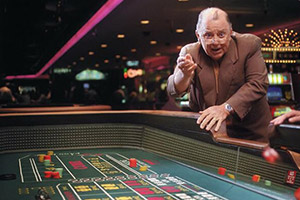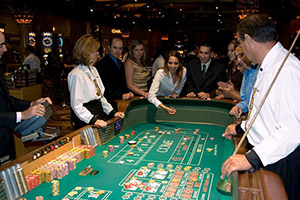
Land-based casinos feature a standard design that is three and a half feet wide by twelve feet long (3.5×12). The table is constructed with heavy wood and a padded leather arm rail for the players. The larger deep cut out section is specially designed to accommodate the boxman and two standing dealers. A smaller cut out section is located on the opposite side and accommodates the stickman.
Best Online Craps Bonuses
Craps tables in land-based casinos could theoretically serve a total of 22 players as there are 22 sections to hold their chips. Normally, there are between 14 and 18 players at the craps table.
The Craps Table Layout
Craps tables have always looked terrifying to players with less experience and some even avoid it. This is exactly why the craps table layout is considered one of the biggest turn-offs that make players give up. However, if played correctly, the game of craps offers quite good odds of winning.
The layout is easier to understand if divided into smaller segments and sections, as players are given the chance to learn them more quickly. Still, players should remember that the craps layout is specially designed to tempt casino customers to place wagers with a high house advantage.
It is important for players to understand that all proposition bets located in the center of the table are structured mostly in favor of the house.
The bets considered the best ones for craps players are the Pass Line and the Free Odds, but players should remember that patience is the key. Not only the house advantage is lower on Pass Line and Free Odds bets, but players' losses are normally decreased when placing their wagers on such bets.
Craps Table Side and Center Sections
The standard craps table layout that is used in both brick-and-mortar and web-based casinos is comprised of two identical sections, the so-called side section, and the center section.
The side sections are managed by a dealer each, which is exactly why there are two standing dealers at the table. It does not matter which end a player would choose to place a wager because the side sections are absolutely identical. On the other hand, the center section of the craps table is managed by the stickman.
No matter what the player's position at the table is, the only area on the layout that applies to them is the side section at the customer's end as well as the center section. All players at both ends of the table share the center section but when it comes to the side sections, they could place wagers on the one at their side only.
Side Sections
Each side section of the craps table layout features two areas, the self-service area, and the dealer's area. There is also a blank part called “apron”. In addition, each of these areas features a variety of bets.
The self-service area of the side section features several bets, including Pass Line, Don't Pass, Field, Come and Don't Come. Some craps table layouts could also feature the Big 6 or the Big 8 bets. The latter is not included in all craps table layouts, because they make the house edge so big that most players would not even consider placing a wager there.
These are the six bets that represent the so-called player's area, which is also called a self-service area since customers are allowed to handle these bets themselves. In order to make one, players put their chips in the block without the dealer's help. When it comes to the Pass, Don't Pass and Field bet, if they have generated a win, the winnings are placed to the player's original bet by the dealer, but it is once again a responsibility of the player to pick up the chips.
Players need to be aware of the fact that in case of leaving the chips on the table, the craps table staff would assume that they press up their bet with its original amount plus the winnings.
On the other hand, the dealer's area includes a total of six square boxes featuring the numbers 4, 5, 6, 8, 9, and 10. These boxes are also known under the name “point boxes”. When a player manages to generate a win, the dealer places the puck in “on” position in the middle of the point box that corresponds to the point number. The point boxes are also used by the dealer in order for the latter to make a number of bets at the player's request. Players are not allowed to put down or pick up any bets within the dealer's area.
Each point box features two thin rectangles as well as one wider rectangle. It is exactly the thin rectangles at the top and bottom of each point pox where the dealer puts players' Place bets. The Lay and Don't Come bets are put by the dealer on the wider rectangles at the top of each point box. Buy bets and Come bets are placed inside the square point boxes.
Center Section
The Centre Section of the craps table layout is shared by all players regardless of which end of the table they are. As already mentioned above, the center section contains the so-called proposition bets and is handled by the stick man. Players are not allowed to operate freely by themselves in this area, so in order for them to make a proposition bet there, they need to get the stickman's attention.
When in a brick-and-mortar casino, players can make their bets by gently tossing their chip over the center of the table and telling the stickman what bet they would like to make.
In case that the stickman is busy dealing with other players' bets, the player could put their chip in the apron and announce their bet to the dealer. Then, the dealer could either put the chip in the center section, or they could wait for the stickman to finish making the other bets and tell them what bet the player wanted.
The Staff

What is interesting about the staff at craps tables is the fact that there are several types of dealers involved in the game. The staff consists of a total of four dealers, one seated dealer called a boxman plus three standing dealers.
A specific feature of craps table staff for brick-and-mortar casinos is the fact that the crew works switches their positions around the table every twenty minutes over their eight-hour shift. The rotation is done without interrupting the game and is traditional for land-based casinos. Of course, such an issue does not exist when it comes to playing at an online casino.
The Floorman
The floorman is the one who is considered as the overall manager of everything happening at the table. It is possible for the floorman to supervise more than one table at a time. They are given the right to approve credit for certain players and who observe the players for any unwanted conduct.
The Boxman
In fact, the boxman is not part of the crew. He is seated with his back to the pit and faces the action at the craps table. His job is to watch the dealers and observe the casino's bankroll over the game at one particular table. Apart from observing everything that happens at the table, it is the boxman who changes chips to cash.
In case of a dispute between a dealer and a player at the table over the gameplay, the boxman has the right to mediate and settle such issues. They need to be fair in administering such disputes by using the standard rules of play.
The Stickman
The stickman is referred to as such because of the long flexible stick they hold in order to manage the dice around the table.
As a matter of fact, the pace of the game is largely controlled by the stickman as it is them who move the dice around the table. At the beginning of the game, three sets of dice are moved by the stickman to the new shooter to give them a chance to choose one. After every throw, the pair of dice are returned to the shooter by the stickman. In addition, after the dice are rolled, the latter calls out the numbers and the effects on some bets.
The stickman also needs to remind players around the table of the opportunity to choose the proposition bets that are placed directly in the center of the table. When a center or a proposition bet is made by a player, it is exactly the stickman who organizes the chips thrown. They also direct the two standing dealers to pay off the winnings generated by center bets.
The Two Dealers

The two sides of the craps table layout are absolutely identical to each other, so it would not matter for them at which half would they stand. The dealers are required to answer to any eventual question asked by the players over the gameplay.
In order for a player to begin their play, they are required to either toss cash on the craps table or request credit in case they have some at the casino. When requesting credit, the latter must be primarily set up at the in-house bank/cage of the casino after a thorough credit investigation.
Once the player gets approval of their credit and the documents required are set and signed, they could proceed to the game. The floorman is to instruct the dealer to grant the player with the appropriate number of chips.
When no credit is requested by the player, the dealers could advance by giving them the chips after the player sets the money down in the special betting box marked COME. Dealers are forbidden to receive or hand any cash or chips directly to and from the players, so they use the COME box for that operation. The boxman counts the money and then counts out the appropriate number of chips from the casino bankroll. The chips are handed to the dealer who will in their turn forward them to the player.
When at a land-based casino, players are not required to “check in” to a certain table. It would be enough for them to simply walk up to the table of their choice and place their chips in a betting box. When the bet is determined as a winner or loser, players are no longer required to stay at the table if they do not want to. Of course, this process is applied only when it comes to playing at regular land-based casinos. Online casinos gameplay is much simpler.
There is a special name for the first roll of the game, a “come out” roll. If a 7 or an 11 is rolled on the come out roll, the dealer will collect or pay the appropriate bets off. In addition, in case that “craps” is rolled, or in other words, a 2, a 3 or a 12, the dealer is required to make the same.
The dealer, however, would be required to place the Marker Puck disk and place it in the appropriate point number box with the “on” side facing up in case that a “point” number (4, 5, 6, 8, 9 or 10) is rolled. Placing the black and white disk with its “on” side up indicates that a game is in progress. On the contrary, when the disk is placed with its “off” side facing up and the table is between games, the disk is usually laid in the “don't come” box by the dealer.












